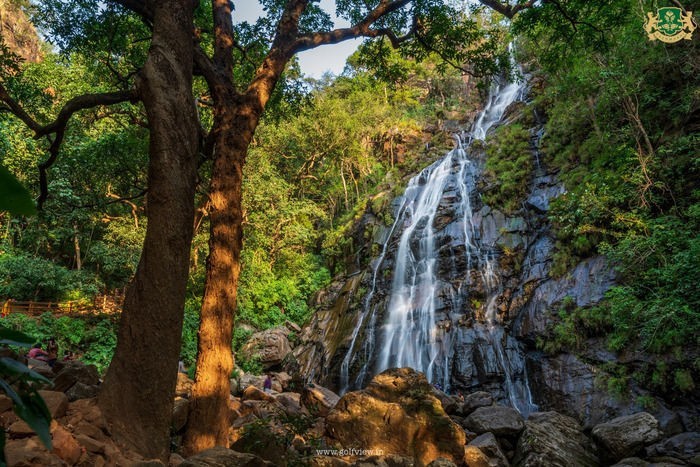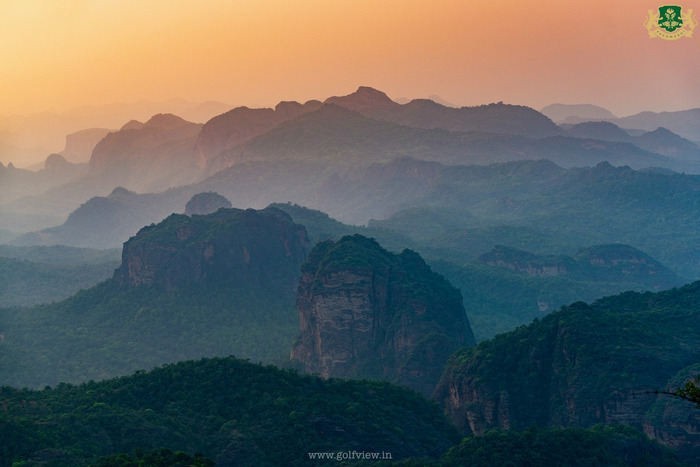| Destination: Pachmarhi |
| Destination Type: Cities |
| City: Pachmarhi |
| Country: India |
By Air : Bhopal airport (195 kms) is the nearest airport. Major airlines connect Bhopal to various cities in India that include Gwalior, Mumbai and Delhi.
By Rail : The nearest rail station is Pipariya (50 kms). It is on the Mumbai-Howrah line and is well connected to major cities like Delhi, Mumbai, Pune, Chennai and Bangalore.
By Road : Bus services to Pachmarhi are available from Bhopal, Nagpur, Jabalpur, Chhindwara, Pipariya and other places. There are 7 buses daily to Bhopal which take just 6-7 hours. Buses are operated by the Madhya Pradesh Tourism Development Corporation as well as other private companies.
Pachmarhi is Madhya PraWater Fallsdesh's most verdant jewel, a place where nature has found exquisite expression in myriad enchanting ways. Green shades embrace the mountains, and everywhere is heard the gentle murmur of flowing water. Bridle paths lead into tranquil forest glades, groves of wild bamboo and jamun, dense sal forests and delicate bamboo thickets.
Complementing the magnificence of nature are the works of man; Pachmarhi is also an archaeological treasure-house. In cave shelters in the Mahadeo Hills is an astonishing richness in rock paintings. Most of these have been placed in the period 500-800 AD, but the earliest paintings are an estimated 10,000 years old.
Situated at 1100 m, Pachmarhi, popularly known as 'Satpura ki Rani' (Queen of Satpura), sits beautifully, embellished by nature and history, amidst the Satpura range. Legend says the Pandava brothers visited Pachmarhi during their exile.
This beautiful region in the hills, was discovered by Captain James Forsyth in 1857. This most popular hill station of Madhya Pradesh is a treasure with ancient caves of the Buddhist era residing in harmony with serene waterfalls.
Pachmarhi is sure to make you feel calm, the way you felt when you put your bare feet on the garden grass for the first time, as a child.
- Priyadarshini (Forsyth Point) : This vantage viewing point marks the place from where Pachmarhi was discovered by Captain Forsyth in 1857. The British developed Pachmarhi as a resort and their influence is embodied in its churches and colonial architecture.
- Jamuna Prapat (Bee Fall) : A spectacular fall in the stream which provides drinking water to Pachmarhi. The bathing pools above the fall are very popular.
- Handi Khoh : Handi Khoh Pachmarhi's most impressive ravine has a 300 feet high precipice and dramatically steep sides.
- Apsara Vihar (Fairy Pool) : Easily accessible from Jai Stambh, this 'fairy pool' is an ideal picnic spot for families with small children, since the pool is shallow, deepening only towards the base of the fall.
- Rajat Prapat (Big Fall) : Those seeking adventure will find it in this ten-minute walk over rocks and boulders from Apsara Vihar to the top of Rajat Prapat, the 'big fall'.
- Irene Pool : This pool was discovered by Irene Bose, wife of Justice Vivian Bose, and named after her. The route upstream leads to a cave, through which the stream goes underground and then over a khud in a series of falls.
- Jalawataran (Duchess Falls) : The descent is steep and the trek strenuous for almost all of the 4 km/2 mile to the base of the fall's first cascade.
- Sunder Kund (Saunder's Pool) : Crossing the stream below Duchess Fall and following a footpath about 2.5 km/1.5 mile in a south-west direction, brings one to a huge rocky pool that is excellent for a refreshing swim.
- Mahadeo : Regarded as holy for countless of generations, Mahadeo hill has a shrine with an idol of Lord Shiva and an impressive Shivlinga. On the East side of the hill is an excellent cave shelter with beautiful cave paintings.
- Chhota Mahadeo : Revered as a sacred spot, this is a narrow point in the valley with rocks overhanging a stream and a spring from where water cascades down.
- Chauragarh : 4 kms/2.5 mile from Mahadeo, it is one of Satpura's prominent land marks, the summit crowned with emblems of Mahadeo worship.
- Jata Shankar Caves : A sacred cave under a mass of loose boulders in which the Jambu Dwip stream has its source. A rocky formation of this place resembles the matted locks of Lord Shiva, hence the name.
- Dhoopgarh : The highest point in the Satpura range, with a magnificent view of the surrounding ranges. A very popular spot for viewing sunsets.
- Pandav Caves : Pandav Caves Five ancient dwellings excavated in the sandstone rock in a low hill. Pachmarhi derives its name from these caves which, as the legend goes, once provided sanctuary to the five Pandav brothers. These caves are now protected monuments.
- Tridhara (Piccadily Circus) : A popular picnic spot where two streams meet in a junction.
- Vanshree Vihar (Pansy Pool) : A beautiful spot on the Denwa stream, cool and shady among trees, ferns and semi-tropical vegetation.
- Reechhgarh : A wonderful natural amphitheater in the rock, approached through a cave-like entrance on the South-side.
- Sangam (Fuller's Khud - Waters Meet) : This is the lowest of the picnic spots on the Denwa and offers fairly good bathing pools both below and above the meeting of the waters.
- Catholic Church : Built in 1892 by the British, the Catholic Church is a blend of the French and Irish arcCatholic Churchhitecture. Its Belgium stained-glass windows add rare attraction and beauty to the building. The church has a cemetery attached to it and graves date from 1859, World War I & II.
- Christ Church : Built in 1875 by the British, this Church's architecture is fascinating; its 'sanctum-sanctorum' has a hemispherical dome on top with its ribs ending with faces of angels. The stained glass panes adorning the walls and rear of the altar were imported from Europe. They present a gorgeous view as the sun rays pass through them. The nave of the church does not contain even a single pillar for support. The baptismal font is a rare brass piece and the bell is as old as the church and its chimes can be heard from a long distance.
- Satpura National Park : Set up in 1981, Satpura National Park is 524 sq km in area. It spreads through dense forest of evergreen sal, teak and bamboo. The high peaks of Dhoopgarh and Mahadeo, Bori's legendary teak and bamboo forests, Pachmarhi's fascinating natural beauty of deep valleys, high mountains, rivulets, waterfalls and Tawa's vast reservoir combine to give this park unique beauty and a breathtaking variety of attractions. The park is home to the bison, tiger, Leopard, bear, four-horned deer, blue-bull and a rich variety of birds.
- Bison Lodge : Constructed in 1862, the Bison Lodge is the oldest house in Pachmarhi. It now houses a beautiful museum depicting the rich flora and fauna of Pachmarhi.
Visit Waterfalls & Caves
Excursions
Bori and Pachmarhi Sanctuaries : Being developed as wildlife sanctuary. Gaur (bison), barking deer, sambar and wild boar are among the animals found here.
Tamia : Overlooking the Narmada valley, Tamia is a picturesque resort on the Satpura ranges. From the Tamia rest house, the view of the Dudhi plateau from 330 metres of sheer overhanging cliffs is one of the most spectacular anywhere South of the Vindhyas. Tamia is 78 km/50 mile from Pachmarhi.
Muktagiri : (298 Km/190 mile)-Situated 97 Km/62 mile from Betul are the 52 Jain temples of Muktagiri.


